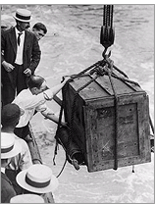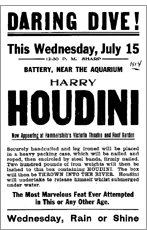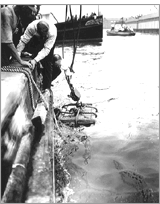
|
| |
1910–1924 | 1925–1926 | 1927–1930 | 1931–1943 | MORE RECENT
THROWN OVERBOARD MANACLED IN A BOX Houdini Bobs Up Smiling in the Harbor, the Box Being Unopened and Still Nailed and Roped. THRILLER UP TO THE BILLS His Head Comes Above the Surface and He’s Free to Swim Just One Minute After the Box Sinks.
It had been announced that the exhibition would take place off Pier 6 East River at 11 o’clock, and as a result the pier was crowded to suffocation. Small newsboys perched themselves on piles, which at any moment might have sent a hundred odd of them into the river. Houdini, his assistants, who numbered at least fifteen, and the box, together with rope and handcuffs, were aboard a barge in tow of the good tug Catherine Moran, which is not unknown to the harbor. Then the newspaper reporters began to arrive, not in ones and twos, but in groups of half a dozen or so. There were at least twenty photographers and a cinematograph operator among the other observers. There were also some policemen present, and they early began to expostulate. They told Houdini in no uncertain terms that they were not going to have any one commit suicide, or anything else, off Pier 6, or anywhere near it. If he didn’t drown himself, it was 10 to 1 that somebody in the crowd would fall into the water. It looked for a moment to the reporters as if Houdini would take advantage of this hold-up and return to his theatre, wooden box, assistants, and all. One Boy Swims for a Sight.
He stood at the bridge of the barge—or on that part of the barge where the bridge would be if a barge had a bridge—and challenged each comer, keeping off all but newspaper reporters, photographers, and assistants. He then informed the police that he was going away from there as soon as the clock struck 11. Exactly at the hour, in fact, the good ship Catherine Moran tugged away. There were howls of disappointment from the shore, and one small boy, feeling it was more than he could stand, bravely tore off his clothes, which he left in the keeping of a friend, and exposed himself in a bathing suit. Plunging into the water, he swam to the tug and climbed aboard, where he was allowed to observe the proceedings triumphantly unmolested. It was said that later in the day his bearing was regarded as insolent by other newsies. The Catherine Moran, meanwhile, made straight for Ellis Island, or thereabouts. Once aboard the lugger, Houdini began preparing for his ordeal, first by removing his clothing, and appearing in a bathing suit of spotless white, in which he posed for his photograph countless times. Overboard in the Box.
Then Houdini was placed in a thick pine box, about the size of an office desk, and, so far as could be discovered, perfectly solid and without any sliding panels whatsoever. Once inside the lid was placed on and nailed down. Then iron bands were nailed around the box, and it was finally securely tied with ropes. Leaded weights were also attached. In these matters some of the assistants of the “mysteriarch,” as his European admirers call him, were the leading spirits. They were constantly surrounded, however, by as zealous a lot of observers as might be desired. The box, it should be stated, was perforated here and there with holes which allowed air to enter, and also water. It was perfectly obvious to any one who has seen Houdini rid himself of handcuffs on the stage in a few seconds that he would be free of his irons before the box touched the water. He had plenty of time for this part of the trick while the men were nailing up the box. When the box was ready another rope with a long end was tied around it and it was gradually lowered into the water. It rapidly filled until it sank to the level of the sea, where it remained-with the top slightly unsubmerged. Comes Up Smiling. The Catherine Moran in the meantime had lowered her lifeboat, a stanch-looking craft, manned by three of the wizard’s assistants on this occasion. They held close to the rope which was tied to the box to keep it from floating dangerously far away, as the tide was going out, and waited. Some of the more excitable onlookers thought the experiment was going a little too far, but a Cockney voice belonging to one of the assistants reassured him, calling out: “ ‘E’s hall right.’ ” And so it appeared, for, smiling and puffing, Houdini appeared, swimming about in the briny, just one minute after he had been lowered from the deck. Two tugs in the vicinity tooted away lustily, and one of the Staten Island steamships bearing out from South Ferry was crowded with people who cheered. Houdini swam to the lifeboat, and, getting tired of waiting for his men to buck against the tide, the going not being good, he swam to the barge and climbed up a rope, hand over hand. Presently the box was hauled aboard, and to all intents and purposes it was in the same condition in which it had gone overboard. The ropes were still bound about it, as well as the steel bands. The cover was nailed on, and apparently there was no means of egress about the box. The experiment was voted entirely successful and sufficiently mysterious to make it more interesting than dangerous. All over, the tug headed for South Ferry, and by the time of her arrival, Houdini was once again dressed in street clothes. He landed quietly in the face of something like a demonstration, and made his way to a motor car, in which he was driven swiftly away. This article is reproduced here only for educational purposes. Please do not copy the text or accompanying images for commercial use.
|
 Harry Houdini, known as the Handcuff King, and whose appearance at a local theatre this week may be a mere coincidence, was handcuffed and leg ironed, placed in a box, which was nailed up and leaded and thrown into New York Harbor yesterday morning in the presence of enough newspaper workers to have got out any New York daily. That he made his escape inside of a minute may be regarded as a foregone conclusion.
Harry Houdini, known as the Handcuff King, and whose appearance at a local theatre this week may be a mere coincidence, was handcuffed and leg ironed, placed in a box, which was nailed up and leaded and thrown into New York Harbor yesterday morning in the presence of enough newspaper workers to have got out any New York daily. That he made his escape inside of a minute may be regarded as a foregone conclusion.
 However, Houdini is of sterner mold than the ordinary man who embarks on an enterprise to please the press agent. He loves to escape from jails, and, according to the literature which he issues to those interested, he escaped from the city prison in Boston in 16 minutes in 1906. He made a similar escape from a cell in Washington in the same year. Siberian locks have no terrors for him, and once in Germany he is said to have freed himself from a pair of handcuffs which, when once locked, could not be unlocked.
However, Houdini is of sterner mold than the ordinary man who embarks on an enterprise to please the press agent. He loves to escape from jails, and, according to the literature which he issues to those interested, he escaped from the city prison in Boston in 16 minutes in 1906. He made a similar escape from a cell in Washington in the same year. Siberian locks have no terrors for him, and once in Germany he is said to have freed himself from a pair of handcuffs which, when once locked, could not be unlocked.
 The handcuffs were passed around also and such newspaper reporters as were expert in detecting flaws in irons examined them. To one of these was entrusted the dangerous-looking leg irons and to another the handcuffs. And when everything appeared to be ready these men fastened the irons on Houdini's wrists and ankles—two to each—while the cinematograph man turned his crank rapidly and the sun beat down mercilessly.
The handcuffs were passed around also and such newspaper reporters as were expert in detecting flaws in irons examined them. To one of these was entrusted the dangerous-looking leg irons and to another the handcuffs. And when everything appeared to be ready these men fastened the irons on Houdini's wrists and ankles—two to each—while the cinematograph man turned his crank rapidly and the sun beat down mercilessly.